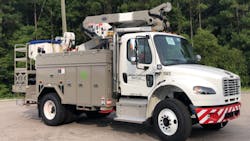FirstEnergy Adds Hybrid Electric Bucket Trucks to Fleet
As part of FirstEnergy Corp.'s efforts to reduce greenhouse gas (GHG) emissions, the first cleaner-powered hybrid electric bucket trucks in its vehicle fleet will be on the road soon, helping to provide reliable electric service to Jersey Central Power & Light (JCP&L) customers in New Jersey.
A total of five new hybrid electric bucket trucks are receiving final inspections at JCP&L line shops — three in Flemington and one each in Washington and Newton.
Hybrid bucket trucks reduce emissions using a high-capacity battery pack motor to power the hydraulic lift rather than idling the diesel engine. Truck manufacturer Altec estimates that utility vehicles idle in park for about 65% of their total engine hours, with an hour of engine idle equivalent to 25 miles of driving. The electric motor runs quietly without any background noise, limiting disturbances to nearby residences and making it easier for crews to communicate with each other.
"These hybrid electric bucket trucks are the first of many that will be added to the FirstEnergy utility fleet in the coming years, substantially reducing emissions while supporting the exceptional service we provide to our customers," said Samuel Belcher, senior vice president, Operations, FirstEnergy. "The initial deliveries are part of our previously announced plans to electrify 30% of our approximately 3400 light duty and aerial fleet vehicles by 2030, with the goal of reaching 100% electrification by 2050."
FirstEnergy's 30% fleet replacement target has the potential to annually eliminate approximately 10,000 metric tons of GHG emissions — equivalent to removing nearly 2,200 cars from the road each year — while saving more than 3.8 million gallons of fuel from 2021-2030.
Additional hybrid electric bucket truck deliveries are expected to be made in areas served by FirstEnergy's West Virginia utilities and Ohio Edison areas early next year.
In addition to powering the aerial bucket hydraulics, the battery pack operates the vehicle's heating and cooling systems while workers are on the job site. The idle mitigation feature also helps extend the life of the vehicle by reducing engine operation time, eliminates certain maintenance expenses and cuts fuel costs over time.
The vehicle self-charges up to 80% of battery capacity while being driven from job site to job site. If the hybrid battery ever gets too low, which could happen during a storm or large restoration effort, the diesel will automatically kick in to provide backup power for the hydraulic lift to continue operating.
To achieve full performance, the hybrid trucks will need to be charged at least once a week. The batteries can be charged off a conventional power outlet. As part of the hybrid bucket truck implementation process, quick charging stations also will be installed at various company facilities so the vehicles can be charged rapidly and ready to go within a 45-minute timeframe, if needed.
The hybrid trucks also are equipped with a sophisticated telemetric system that collects data on the amount of emissions, fuel, and engine hours saved, as well as the time the battery was charged, utilized or overridden should the operator use the diesel setting. The information is transmitted to the FirstEnergy fleet managers for tracking and review.
FirstEnergy's overall climate strategy targets a 30% reduction in GHG emissions within our direct operational control across the entire company enterprise by 2030, based on 2019 levels, as we strive to become carbon neutral by 2050. Replacing conventional utility trucks with electric and hybrid vehicles is part of FirstEnergy's forward-thinking perspective and renewed commitment to environmental stewardship that will help enable our customers and communities to thrive in a carbon-neutral economy.
